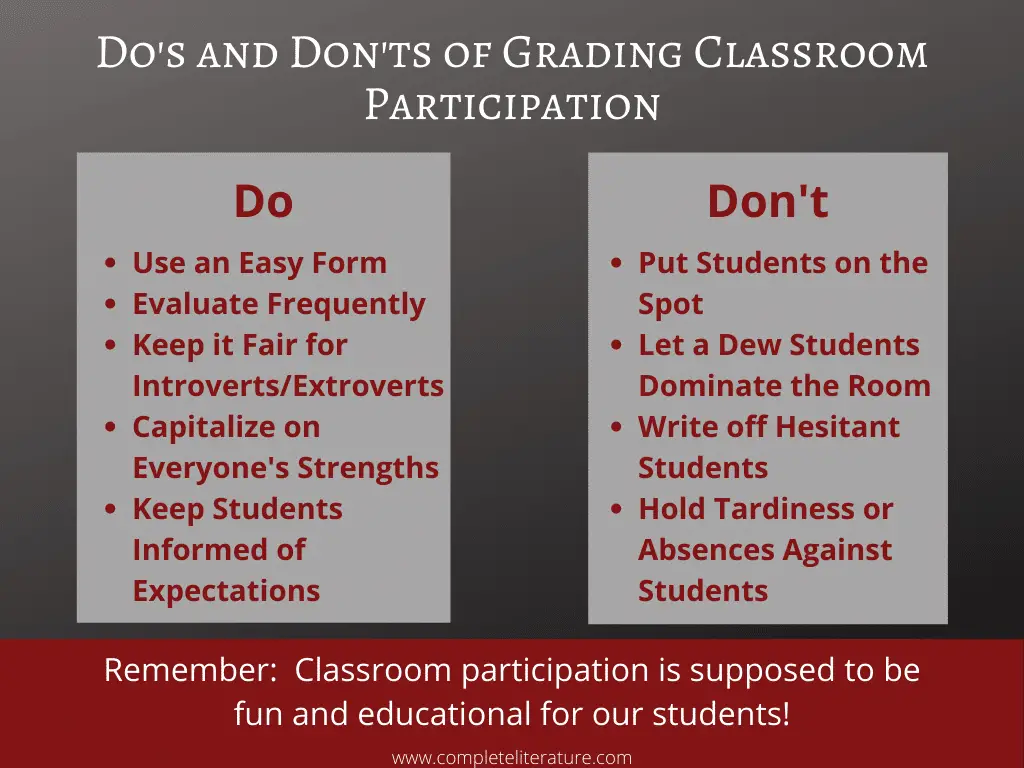Student participation is critical in the classroom and literally in every age range. Teachers need it to be able to help gauge how well students are grasping the material they are learning. And students need it to reinforce what they are learning. So it makes sense that such a necessary part of education should be included in the grading process.
So then, how do we grade student participation and what is the most fair approach? Grading student participation is most effective and fair when the teacher is able to help the students exhibit their brightest and best work and accurately reflect that in their grades. Having a form to fill out on a regular basis will allow her to take advantage of information that is fresh in her mind. And the form allows her to give an actual grade based on the level and types of participation. In addition, this allows her to see what students are lacking and be able to work with them to bring them up to par. Of course, it must be complementary with traditional testing methods of written and oral tests and evaluations.
Let’s take a look at how all of that plays out in the classroom.

Table of Contents
What Constitutes Student Participation?
Student participation is much more than the teacher asking a question and students dutifully raising their hands to give the answer.
While that is certainly still part of student participation in today’s classrooms, there are many other ways to get the same and better results.
Here are a few of the ways you can encourage student participation:
- Have your students that are more knowledgeable in the material help out students that have been absent or had trouble catching on to the concepts.
- Having students work in small groups (3 or 4) to present material to the class.
- Make it a game–Jeopardy and Family Feud are great formats, although any quiz form will work. Even playing 4 corners, with each corner being an answer option or a project choice. This could go in so many directions. The more creative the teacher, the more limitless the games.
- Guide students who are less eager to speak out so they don’t feel like they are being put on the spot.
Why Should We Grade Student Participation?
One of my daughters could learn everything about a subject and be able to tell you anything you need to know about it. Then on test day, she would take the test. When she came home, I would ask her how she did, and her response was almost always positive. She felt that she did a great job. Then she would get the test back and realize she hadn’t done nearly as well as she thought.
It was such a frustrating time for her because she really did know the material and was very intelligent. But for whatever reason, she was just not a great test taker.
On the other hand, her classroom participation skills were through the roof. She has always been a social butterfly, so classroom participation was totally her jam. She enjoyed the dialog, the activities and just had fun interacting with people. So the more interactive a class was, the better her grade would be.
This is exactly why we should grade student participation. By allowing students to display different methods of learning, we allow them to more accurately assess what level of knowledge they actually hold in relation to the material they are learning.
The biggest advantage is that it allows the students to express themselves academically in ways that they are comfortable with. This will, in turn, balance out the learning difficulties with the learning strengths. And all of your students will find their grades reflecting that balance.
The Rest of the Story
As for my daughter’s test taking woes, we studied the heck out of SAT test-taking courses and her score was the same as the Salutatorian of the corresponding public school in our district! And with that, she went on to get her Bachelor’s degree with an above average GPA. But in addition to her increased testing skills, she still capitalized way more on her classroom participation skills. And most of her professors did an excellent job of recognizing her academic strengths.
Let’s go ahead and look at some of the ways student participation actually helps the student, not only in the classroom, but in preparing for adult life and work.
It Helps the Students Reinforce What They are Learning
Studies have long shown that people learn better when they learn in a variety of ways. Learning increases exponentially when students are allowed to experience their academics in ways that they enjoy. And when the teacher uses several different methods of learning and coordinate them with activities that a majority of the class can appreciate, students then truly learn the material–not just for the test, but in a very practical and real-life way.
This type of classroom participation also allows students to take control of some of their learning. Most kids know what their academic strengths are. By default, they are the things that students enjoy doing the most. Upon choosing the things they would like to participate in, they will inevitably learn the material much better.
So their educational experience is better for them and the teacher, and their grades reflect that. When their report cards go home, parents are then pleased with their performance and the teacher’s ability to help their child learn well. It is a win-win for everyone!
It Helps Develop Social Skills
Whether they are playing games and learning to interact in play, play by the rules, and win and lose gracefully, students are learning the give and take of life while at the same time learning about particular dates in history, multiplication or division tables, great literature concepts, or whatever it is that you are trying to teach them. You can literally use this with every single thing you teach. You can even use this for character training and other extracurricular subjects.
The point here is that your students aren’t just learning academics, they are learning life.
Just remember not to call out kids in front of everyone if there is an issue. Diffuse the situation as quietly as possible and then use it as a teaching moment later when you have an opportunity to go over it with the student having difficulty.
Especially in middle school, your kids are still learning how to be more graceful and dignified in their everyday activities. Making the classroom a comfortable place to learn and grow will do wonders toward teaching your students social skills, regardless of what they are doing in class. The more it emulates real life, the better!
It Helps Everyone to Get to Know Each Other Better
The more your students are interacting and the less they are just sitting at their desks listening to you talk, the more they are getting to know one another. They are learning how others think, what experiences they bring to the classroom, people that have influenced them, what they love as well as what they hate, and many other things.
And the more students get to know one another, the better they work with each other.
And honestly, the more this becomes true in your class, the more social skills your students are developing, lending even more to the point we just covered before this one.

It Makes for a More Well-Rounded Education
Learning things that the students can take into their adult life, work, and relationships makes for an incredibly well-rounded education. Granted, they won’t be turning what they are learning at work into games (well, they may be sometimes). But just the idea that they are learning to participate and work with one another helps them learn how to work with people of all different walks of life. And that is a critical life skill.
How we learn is infinitely more important as we move toward adulthood than just learning facts. Because at the end of the day, we aren’t just teaching our students facts. We are teaching them about life!
It Helps Students Gain More Confidence
The more that students feel they are learning, the more confident they become in class. This is also true as they get to know the other students and become more comfortable around them.
Knowing that their teacher truly cares about them and what they are learning also helps to build more confidence. They know you are looking out for them, and they will trust you more with their hearts and thoughts.
The more self-assured you help your students to be, the more you will find them gaining confidence. Is there a more valuable thing you can do for their future? Of course the information they are learning in your class is critically important too, but when you combine knowledge with life skills, you are helping to train the greatest leaders our society will have in the near future!
How To Grade Student Participation
Have an Easy and Quick Form to Help You
In my experience, the easiest way to grade student participation is to have a form that quick and easy to fill out. It can’t be too complex or it will take you forever to fill it out for all of your students on a regular basis. The last thing teachers need is one more expansive job to do.
Here is a form that I have used. Feel free to print it and use it. Or, if you prefer, you can use it as a guide to make your own. Because it isn’t a worksheet or anything the kids will be working with, I kept it super simple. And the grading rubric is included, but feel free to change that to what works for you as well.
Evaluate Students Frequently
It is super easy to forget how all of your students performed in class on any given day. There were so many times that I noted something mentally and was sure I could remember it until I got a chance to write it down. And then the opportunity never presented and I realized I had lost the memory of who did what that should have been noted.
The only thing to remedy this is to write a quick note immediately, whether it is the initials of the person you would like to note, or maybe a two or three word phrase indicating the thing you would like to note. Obviously, we aren’t going to stop in the middle of class to fill out the form. But if we can take a quick note on a small piece of notepaper, it will help us to remember those details after a long day.
Checking in on the list frequently will also help you to see those students that aren’t getting a lot of face time with you. You can adjust that before the end of the quarter/semester and be able to help those students improve their grade before it’s too late.
Make it Fair for Introverted Students
There are some students that you are positive have all of the answers. But they would never in a million years raise their hand to answer or volunteer to get up in front of the class. You also know that putting them on the spot and forcing it would be devastating to their daily classroom life. (More on that in a bit.)
So what do you do in cases like this? I have found that just having a casual conversation with them at some point in the day will work wonders for them opening up in the long run. The more you acknowledge them and their ability to share their knowledge with you, the more confidence they will build up.
As an intermediate action step, you can also talk to them in the same casual way, but with one or two other students that you know will be empathetic and caring towards the introverted student. Upon seeing the support extending out beyond the teacher, it helps the introverted student to feel more comfortable sharing their thoughts in front of several others.
For more ideas on working with introverted students, check out my article here.
You will also find some great related information in the Madeline Hunter Lesson Plan article here because much of the work she did focused on how best to reach ALL of your students.
The bottom line here is that if you can’t draw out your introverted students in a way that is comfortable for them, you won’t be able to grade their classroom participation. Getting them to be comfortable in their surroundings not only helps you to get that grade supplemented, it also helps them to grow in social skills they will need for a lifetime.
Capitalize on ALL of Your Students’ Strengths
Every single one of your students has a strength in something. Some are great with reading aloud, some are great at repeating back everything they heard verbatim. Some have a photographic memory and will remember everything easily. Others’ strengths include amazing auditory memory. And some students are just really good at creativity and coming up with great ideas to do and learn.
It is our job as teachers to figure out each of our students’ strengths in learning. Sometimes it may take a little bit of time to figure them all out. You will figure out many almost immediately. But for the students who specialize in flying under the radar, you will have to work a little bit harder to figure it out.
Everybody who know me knows I have a book for everything. And this is the book that was a lifesaver for me:
While some of the information is very common sense (which certainly isn’t a bad thing, especially for setting up context), there was so much meat in this book! It is a reference that I still look through when I feel like a have a student that seems to hard to figure out. And I am never disappointed. In addition to getting the solution I was looking for, I always get a couple of other nuggets that are perfect for adding to my student participation routine.
A Perfect Example
For example, I as I was looking through the book shortly after the school year started last year, I was reminded of the Bounce Card idea. Although I had always liked the idea, I had never taken the time to implement it (sometimes it’s just hard to change up the routine, isn’t it?). Because I was reading the book on a Saturday morning, I had time to actually think through implementing it.
So I printed up the Bounce Cards on card stock (one per student), and then planned to use them on the following Monday.
We finished our history class, and then I pulled out the cards and handed them out. Because it was a new concept, I just used the first example of “This reminds me of…” to have the students reiterate what they had learned. I started by finishing the statement myself so they could see how it was done. Then I asked for some volunteers.
It was an instant hit. And the next time, I didn’t limit the use of the cards at all. They took it and ran with it. I think what they loved is that they felt in control of what they were doing rather than answering a pointed question from me. And then I wished that I had been using the Bounce Card Technique from the first time I read about it.
This activity made it very easy for me to rate and eventually grade each student’s participation because they were each getting a turn to directly share what they were getting out of the lesson without me having to figure out who to call on.
Keep Your Students Informed Regarding Student Participation
My final thought regarding how to grade student participation is to not keep your students in the dark. Make it clear to them that you are welcoming their participation in class. Many students may not be used to a teacher who is eager to hear what they have to say in the middle of class if the are used to a more rigid traditional classroom.
And the bottom line here is that students will have no idea what YOUR preferences are regarding classroom life. We sometimes forget that our students have to get to know us as much as we are getting to know them. Being open and honest about your plans and expectations in the classroom will help the adjustment to go even better. And they more they see you are comfortable with them being active in different forms of classroom participation, the more quickly they will open up and be eager to respond well.
Of course, the more outgoing ones will jump on the bandwagon instantly. It may take some time for the more reserved ones. But as they see others participating, it will be helpful for them to come around.

What NOT to do With Student Participation
Now that we have gone over most of the best practices that I have learned over the years, here are the things that I learned not to do.
Putting Students on the Spot NEVER Works!
Many students know all the answers but will never raise their hands. And there are many good reasons for this problem. Sometimes the students are just too shy. Other students may be afraid of being laughed at if their answer is not correct or too unusual. And still other students may not answer because they figure someone else can answer just as well.
If you try to force them to respond just because you want to hear them repeat the correct answer, you will most likely not get the correct answer, at least not in its full form. And you will not get an improved grade from that introverted student(s), even though they probably did know the answer.
What you will get is a miserable student who no longer even cares about improving their grade.
Don’t Let A Few Students Dominate the Classroom
On the other hand, you may have students that dominate the classroom interaction time. Some students love to be the center of attention and will “take the stage” as often as they can. Others will take more than the normal share of time because they are seeking the teacher’s approval.
Putting a limit on the amount of time a student has to answer can help with this problem. That way the particular student with the problem won’t feel targeted if it is a class-wide policy. Having a timer makes it even more “set in stone.” Once they hear that bell go off, they will know it’s time to wrap it up. And it will be easier for you to tell them they cannot go over because it isn’t fair for the other students.
If you need an awesome timer for your class, here is one my students love:
One more thing I did that was careful not to call out students in an embarrassing way but still took care of the problem was to put a designated number of names on the board. Those would be the students I would be calling on. Once I called on them, I would erase their name, showing who was left.
This technique actually serves a few different purposes. If students can see their names on the board, they aren’t wondering if they will be randomly called on. They will know they will be participating in some way.
And for the students that tend to dominate, once their name has been erased, their turn is done and it is time for one of the others to participate.
Don’t Write Off Students Who are Less Eager to Participate
Generally speaking, those students who aren’t chomping at the bit to participate aren’t being that way to be difficult. They also may actually be eager to participate, but just not in the way you are expecting.
You could always have a discussion with those students to find out what type of participation does appeal to them. You can ask them for suggestions. Or you can give them a choice of a few things and see what they jump at.
As with most things in life, communication is key.
And honestly, sometimes you will get that one student who genuinely does not want to participate in anything that has to do with interacting with the whole class. For those students, you will just want to scale down the participation to pairs or very small groups to build up their confidence. You would be surprised what a year of support does for an introverted student, or whatever is causing them to not be eager to participate.
Don’t Hold Absences or Tardiness Against Middle School Students
The one thing that I stopped doing early on was dock a student’s participation grade because they were late or absent from school.
If they are justifiably absent, we can’t hold that against them. Life happens.
And for students that are tardy, whether an isolated case or a more frequent occurrence, we still can’t hit their grades.
If a middle school student is late, it is likely not their fault. So lowering their grade because their ride or bus was late is just not going to be good for their morale or encourage better performance. All that will do is exasperate your child.
My oldest daughter (sorry, she has been quite the example in this article) ran into this probably in the small private school she was at for 4th grade. Because there was no bus system and we lived 20 minutes away from the school, we decided to carpool. Unfortunately, the people who lived close enough to carpool with us were chronically late. And as early as we were ready, my daughter was repeatedly late for school. It was so frustrating for my daughter to get to school and immediately be in trouble for something that was not her fault.
We ended up walking away from the carpooling arrangement, and I took my daughter to school myself until we decided it was time to home school.
The moral of the story is that in elementary and middle school, there are some frustrating things that we just can’t hold against the students. It is incredibly frustrating for them and could cause them to just give up on everything else if you place expectations on them that they can’t do anything to fix.
Conclusion
This is what my research and experience have led to regarding how to grade student participation and finding a fair approach in dealing with it. I am sure you all have found lots more options than what I have here. I would love for you to share them with us in the comments!




I think grading student participation is a great idea. I love that it helps kids like your daughter keep their grade up with their interaction and it encourages more introverted students to step up and participate.
I had had such an approach at school! As a student I would have appreciated it and I think it would have stimulated me to be better!
This is such an interesting read on grading participation. I could see how this could be tricky to grade fairly, but this was was extremely helpful!
Kileen
cute & little
This has such great suggestions! I loved how you didn’t forget about the introverted students!
I guess I would have flunked out of school for being shy!
This is awesome advice for teachers, I have friends that I know will very much appreciate this. Thanks!
Great advice for sure!!! Especially and as you rightfully said, it reinforces the learnings and that is essential.
Wow! These are some great ideas! I always knew participation was important, but now I know the why!
As a kid, I was very introverted and nervous about participating vocally. When it came time for participation marks, I was always nervous about failing because of my shyness.
I wish teachers would read this. It’s best to know how to really grade when its a group activity.
With practically every parent homeschooling during lockdown, this is just what the doctor ordered!!
Fantastic post and very informative too.
This is such great advice! Thanks for sharing!
Right now, during the virtual learning, I am witnessing how some teachers grade student’s participation. I need to say that teachers are incredible of getting creative and getting all kids involved.
Grading students’ participate is a great idea. I hope we’d do that here. It would help better than relying on their exams scores alone.
That alone is not enough to weigh them.
This is such an interesting read. It’s always interesting to read these things from parents perspective. Thanks for sharing.
It warms my heart how you take consideration for introverted students and those who are not keen on participating. It is likely they can shine in a different way but giving them activities to still work on how they can participate better improves their holistic capacity.
This is so helpful. My husband is a teacher and sometimes we talk about how challenging to rate something that is not concrete or objective. Thank you for sharing these tips. I forwarded this post to him.
I get a lot of useful information from your blog! Thanks for sharing!
Grading student participation is tricky. I love your tips though. I tried to keep participation a small but effective percentage of the student’s grade.
I am soon going to be a teacher and you have taught me how to grade the students. Thanks a lot.
This is so helpful. Thank you for the rubric!